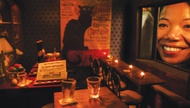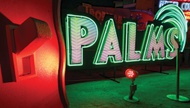It can be easy to let the Goldwell Open Air Museum slip out of mind, seeing as how it’s near Rhyolite, which is near Beatty, which is near no place you’ve been lately. If prompted, you’ll probably recall it as that site where a few crazy European sculptors erected some work in, what, a ghost town or something? Otherwise, you may not be keeping close track.
And yet, at a time when we worry about the fragility of our cultural institutions—with the departure of Libby Lumpkin from the Las Vegas Art Museum; with the Las Vegas Philharmonic possibly paring down its performance schedule; with this lousy, grinding economy tightening everyone’s screws—the scrappy Goldwell operation is pushing ahead, actually building.
It’s set up an ambitious program of artists’ residencies, bringing in a handful of serious artists from around the country for periods of two weeks or a month, giving them $500 per week and all the productive solitude they can handle. “It’s important to have new ideas brought into the state,” says one of the museum’s main caretakers, the tireless Suzanne Hackett. “Otherwise, it’s easy to get insular.”
The artists for this first round of residencies, just announced: Scott Ludwig; Jeff Eisenberg; Keith Conley; Eve Andre Laramee; David Sanchez Burr; Craig Colorusso and Richard Vosseller; Andrea Polli and Chuck Varga; and Raymond Ghirardo and Megan Roberts. A couple—Conley and Burr—are local boys, and the rest come from as far away as San Francisco, Boston, North Carolina and New York City.
More
- From the Archives
- Ghost town art (2/21/08)
- Beyond the Weekly
- Goldwell Museum
The first resident, Ludwig, will arrive in April.
The deal: The artists will have studio space at the Red Barn Arts Center—part of the Goldwell facility—and will create work somehow related or responding to the surrounding Amargosa desert. “We’re very much about place,” Hackett says. “This area brings out the creativity in a lot of people. Maybe because there’s not a lot out here that’s apparent at first. There’s a real richness here, but you need solitude to find it.
“These will be serious investigations into contemporary art,” she adds. “They’ll deal with issues related to that landscape—environmental issues, alternative energy … We’ve got this place that transcends Southern Nevada, because of where it is. People have a strong reaction to this landscape, and to the fact that art was put out here.”
Back in the mid-’80s, Belgian sculptor Albert Szukalski installed the first sculpture there, a re-creation of Da Vinci’s “Last Supper” peopled by plaster ghosts. Backdropped by the upper Mojave desert, it took on an eerie beauty; it wasn’t long before another half-dozen pieces were added by various artists. Hackett and her husband, Charles Morgan, a noted photographer, got involved in 1994, and eventually a nonprofit was created to protect the existing art and extend Szukalski’s dream of creating more. The Goldwell Open Air Museum is now a nearly 8-acre facility. Morgan is president of its board; Hackett is secretary-treasurer.
“When Albert was dying [in 2000], he said, ‘Keep it going,’” Hackett says. “This program is what he had in mind. This is a real evolution of what Albert was doing out there.”
In 2007-2008, Goldwell hosted a couple of invited residents; this new round represents the first competitive selection. “We had 60 applications,” she says, “and for the most part, they were all good.” A panel of arts professionals sifted through them for the final group. (Applications for the second round are being accepted until March 1.)
Of course, artists’ residencies require a residence. The Red Barn isn’t ready for full-time habitation, so Hackett and Morgan did what they usually do: took action. “Charles and I bit the bullet, cashed out a mutual fund and bought a place in Beatty to be the artists’ housing.”
But Hackett expects the payoff to be worth it. “This will raise our profile nationally, for sure, because of the level of artists we’re working with. And for the whole state. As a nonprofit and an arts organization, if you’re not trying to work at the highest levels you can, you’re not really doing anyone any favors.”
Meantime, the Goldwell Open Air Museum isn’t just cooling it until Ludwig arrives in April. Hackett is waiting on word about a $40,000 Warhol Foundation grant she thinks the museum might win, and there’s planning to do for a big printmaking conference to be held there in 2010. Plenty to do.
“Don’t forget to say I’m having fun,” she adds. Of course. Hanging out with fine artists in a creative place you’ve helped wrestle from the desert—who wouldn’t be having fun in those circumstances?






Previous Discussion: